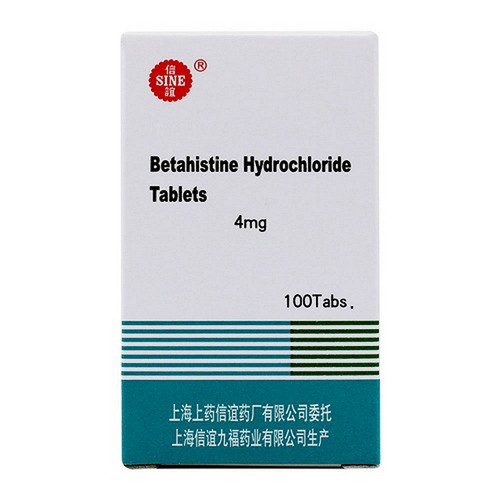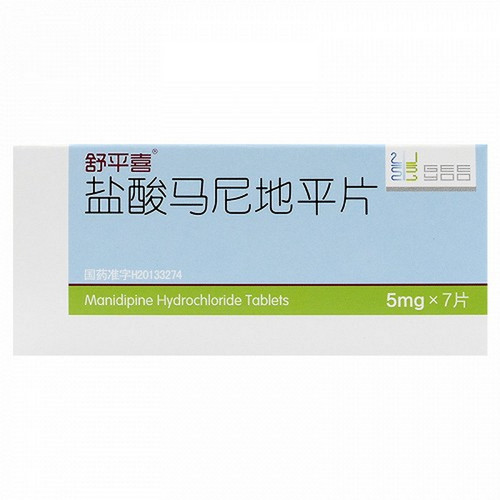Product Overview
[Drug Name]
Generic Name: Benidipine Hydrochloride Tablets
Trade Name: Colilol
English Name: Benidipine Hydrochloride Tablets
Chinese Pinyin: Yansuan beinidipingpian
[Ingredients]
Benidipine hydrochloride. Chemical Name: (±) (R*)-3-[(R*)-1-Benzyl-3-piperidinyl]-5-methyl-2,6-dimethyl-4-(3-nitrophenyl)-1,4-dihydro-3,5-pyridinedicarboxylate hydrochloride. Molecular Formula: C28H31N3O6·HCl. Molecular Weight: 542.03
[Properties]
Tablets
[Indications]
Indicated for essential hypertension.
[Dosage and Administration]
Take orally after breakfast. The adult dosage is usually 1-2 tablets (2mg-4mg) once daily. The dosage should be adjusted based on age and symptoms. If the effect is unsatisfactory, the dose can be increased to 4 tablets (8 mg) once daily. Patients with severe hypertension should take 2-4 tablets (4-8 mg) once daily.
[Adverse Reactions]
Common adverse reactions are listed below and should be carefully monitored. If abnormalities occur, the dose should be reduced or the drug should be discontinued, and appropriate treatment should be implemented. 1. Liver: A small number of patients (0.1-5%) experience signs of liver damage, such as elevated GOT, GPT, γ-GTP, AI-P, bilirubin, and LDH. Therefore, careful observation is required, and the drug should be discontinued if abnormalities occur. 2. Kidney: A small number of patients (0.1-5%) experience elevated BUN and creatinine. 3. Hematology: A small number of patients (0.1-5%) experience decreased white blood cell count and increased eosinophils. 4. Circulatory System: A small number of patients (0.1-5%) experience palpitations, facial flushing, hot flashes, and low blood pressure. A very small number of patients (0.1%) experience chest heaviness, bradycardia, tachycardia, and some experience premature contractions. 5. Nervous System: A small number of patients (0.1-5%) experience headache, heaviness of the head, dizziness, unsteady gait, and orthostatic hypotension. A very small number of patients (0.1%) experience drowsiness and numbness. 6. Digestive System: A small number of patients (0.1-5%) experience constipation. A very small number of patients (0.1%) experience abdominal discomfort, nausea, heartburn, thirst, and some experience diarrhea and vomiting. 7. Allergies: A small number of patients (0.1-5%) experience rash. A very small number of patients (0.1%) experience pruritus. Some patients may also develop photosensitivity. If rash, itching, or photosensitivity occurs, discontinue the drug. 8. Other: A small number of patients (0.1-5%) experience edema (face, calves, hands) and increased GPK. A very small number of patients (0.1%) experience tinnitus, redness or warmth in the fingers, shoulder stiffness, cough, frequent urination, and fatigue.
[Contraindications]
The following patients should not use this drug: 1. Patients with cardiogenic shock; taking this product may worsen symptoms. 2. Pregnant women, women who may become pregnant, and breastfeeding women are contraindicated.
[Precautions]
1. Use with caution (the following patients should use the drug with caution) 1) Patients with low blood pressure. 2) This product may aggravate liver damage, so use with caution in patients with severe liver damage. 3) Elderly patients [refer to (Drug use in elderly patients)]. 2. Important basic precautions 1) There have been reports of cases of worsening symptoms when calcium channel blockers are suddenly discontinued. Therefore, when discontinuing this product, the dosage should be gradually reduced and careful observation should be made. In addition, patients should be advised not to stop the drug on their own. 2) Taking this product may cause excessive lowering of blood pressure, transient loss of consciousness, etc. If such symptoms occur, the drug should be discontinued and appropriate treatment should be given. 3) Hypotension may sometimes occur 3. Other precautions: It has been reported that patients undergoing continuous outpatient peritoneal dialysis sometimes have turbid dialysis fluid, so it is important to differentiate it from peritonitis. [Use in pregnant and lactating women] 1. Animal experiments (rats and rabbits) have shown that this drug is fetotoxic. Administration in the late stages of pregnancy prolongs the gestational period and delivery time. Therefore, pregnant women or women who may become pregnant are prohibited from using this drug. 2. Animal experiments (rats) have shown that this drug can be distributed into breast milk. Therefore, lactating women are prohibited from using this drug. , if this product must be used, breastfeeding should be stopped. [Drugs for children] The safety of this product for children has not been established. [Drugs for the elderly] 1. Other antihypertensive drugs: The antihypertensive effect is enhanced, which may cause excessive lowering of blood pressure. 2. Digoxin: Inhibits digoxin secretion in the renal tubules, increasing the concentration of digoxin in the blood. It may cause digitalis poisoning. 3. Cimetidine: Cimetidine inhibits the calcium channel blocker metabolizing enzyme in the liver microsomes, while reducing gastric acid and increasing drug absorption. It may cause excessive lowering of blood pressure. 4. Rifampicin: Rifampicin induces the liver's drug metabolizing enzymes, promotes the metabolism of calcium channel blockers, and can reduce benidipine 5. Grapefruit Juice: Grapefruit juice inhibits the metabolism of this drug in the liver, increasing its blood concentration. This may cause excessively low blood pressure.
[Overdose]
Overdose may cause an excessive decrease in blood pressure. If severe hypotension occurs, appropriate measures such as lower extremity elevation, intravenous fluid administration, or administration of pressor medications should be considered. Furthermore, due to the high protein binding rate of this drug, dialysis is ineffective.
[Use in Special Populations]
Precautions During Pregnancy and Lactation: Contraindicated in pregnant women, women who may become pregnant, and women who are lactating.
[Drug Interactions]
1. Absorption. 2. Distribution. 1) Distribution in tissues (Reference: Rat data) After oral administration of 1 mg/kg of 14C-benidipine hydrochloride to rats, benidipine was primarily distributed in the liver, kidneys, adrenal glands, submandibular glands, lungs, pituitary glands, and pancreas, with lesser distribution in the brain, spinal cord, and testes. 3. Metabolism. Based on the detection of metabolites in human plasma and urine, as well as metabolic studies in animals, it is believed that the main metabolic reaction in humans is the removal of 3 The benzyl group on the 2-position side chain is N-dealkylated, the 1-benzyl-3-piperidinyl ester at the 3-position and the methyl ester at the 5-position are hydrolyzed, the dihydropyridine ring is oxidized, and the methyl group at the 2-position is oxidized. 4. Excretion (Reference to UK trial results): Five healthy Western European adult men were given a single oral dose of 8 mg of 14C-benidipine hydrochloride. The cumulative excretion rate of radioactivity was approximately 35% of the total dose in urine and approximately 36% in feces within 48 hours after administration. Within 120 hours after administration, the urinary excretion was 36% and the fecal excretion was approximately 59%.
[Pharmacological Action]
This product is a dihydropyridine calcium antagonist that binds to the DHP binding site of cell membrane potential-dependent calcium channels, inhibiting calcium influx and thereby dilating coronary arteries. arteries and peripheral blood vessels. In addition, this product is widely distributed in the cell membrane, mainly entering the cell and binding to the DHP binding site. In addition, through the study of the in vitro vasoconstriction inhibitory effect and the affinity of the DHP binding site, it is proved that this product has a strong binding to the DHP binding site and a very slow dissociation rate, so it shows a sustained pharmacological effect, which is not correlated with the blood drug concentration. 1. Antihypertensive effect: Oral administration of this product to spontaneously hypertensive rats, DOCA-salt hypertensive rats, and renal hypertensive dogs shows a slow and sustained antihypertensive effect. Long-term administration does not produce drug resistance. When patients with primary hypertension take this product orally once a day, it does not affect the daily changes in blood pressure and shows a stable antihypertensive effect within 24 hours. 2. Anti-anginal effect: This agent has a significant improvement effect on experimental angina pectoris models (rats) and cardiac dysfunction and ischemic electrocardiographic changes caused by coronary artery ligation and reperfusion in dogs. When this product is orally administered to patients with exertional angina pectoris, it is shown that this product has an improvement effect on ischemic changes (ECG ST segment depression) caused by exercise load. 3. Protective effect on renal function: When this product is continuously orally administered to spontaneously hypertensive rats with renal insufficiency model (5/6 nephrectomy), it shows a hypotensive effect while improving renal function. When patients with primary hypertension take this product orally, a significant increase in renal blood flow can be seen. After oral administration of this product, patients with hypertension and chronic renal insufficiency have a significant increase in creatinine clearance and urea nitrogen clearance, indicating a protective effect on renal function. 4. Inhibition of vascular remodeling and protective effect on vascular endothelium: This product activates endothelial NO synthase (eNOS) and enhances eNOS gene expression increases NO production and inhibits NO inactivation through its antioxidant effect, ultimately expanding NO biological activity, thereby inhibiting vascular remodeling and protecting the vascular endothelium. [Pharmacokinetics] 1. Absorption. 2. Distribution. 1) Distribution in tissues in vivo (Reference: Data from rats) After oral administration of 1 mg/kg of 14C-benidipine hydrochloride to rats, benidipine was mainly distributed in the liver, kidneys, adrenal glands, submandibular glands, lungs, pituitary glands, and pancreas, with less distribution in the brain, spinal cord, and testicles. 3. Metabolism. Through the detection of metabolites in human plasma and urine and the metabolic studies on animals, it is believed that the human metabolic reaction is mainly the removal of 3 The benzyl group on the side chain (N-dealkylation) is hydrolyzed at the 3-position benzyl-3-piperidinyl ester and the 5-position methyl ester, the dihydropyridine ring is oxidized, and the methyl group at the 2-position is oxidized. 4. Excretion (Reference to UK trial results): After a single oral dose of 8 mg of 14C-benidipine hydrochloride in five healthy Western European male adults, the cumulative excretion rate of radioactivity was approximately 35% of the total dose in urine and approximately 36% in feces within 48 hours after administration. Within 120 hours after administration, the urinary excretion rate was 36% and the fecal excretion rate was approximately 59%.
[Storage]
Sealed and stored in a dry place.
[Specifications]
4mg x 7 tablets
[Approval Number]
National Medicine Standard No. HJ20181249
[Manufacturer]
Company Name: Kyowa Hakko Kirin Co., Ltd., Fuji Plant











